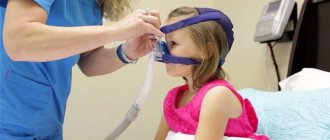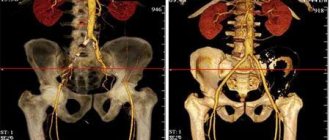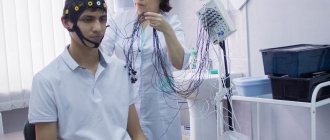In the first year of life, quite a lot of diseases, defects and anomalies in the development of internal organs do not have obvious manifestations.
Ultrasound allows you to correctly diagnose in the early stages of the disease, prescribe treatment in a timely manner, and often improve the prognosis and quality of life of the child.
The importance of timely ultrasound is emphasized by the fact that its use in young children is strictly regulated by the Orders of the Ministry of Health and Social Development, which allows its use in screening (that is, mass) diagnostic programs and detection of diseases at the earliest stages.
Absolutely every person has encountered an ultrasound examination. Currently, there are practically no organs that cannot be “seen” using ultrasound. Restrictions exist only for the lungs and bones.
Examination of children under 1 year of age
using ultrasound has a number of advantages compared to other types of examinations - it is not painful, not dangerous, quite fast and, most importantly, very informative. Even very premature babies weighing less than 1 kg can be examined.
Main research:
Ultrasound of the abdominal organs, kidneys and urinary tract, hip joints, brain (neurosonography), ultrasound of the heart (echocardiography) and other organs.
Ultrasound of the abdominal organs
Conducted for all children at the age of 1 month at the first full examination in a children's clinic.
The study evaluates the size of the abdominal organs, their structure and relative position, as well as the presence of additional formations, inflammatory changes, and traumatic injuries. Based on the results of an ultrasound of the abdominal organs, damage to the liver, gallbladder and bile ducts, and pancreas can be detected. The most often excluded are:
- inflammatory diseases (hepatitis - inflammation of the liver, cholecystitis - inflammation of the gallbladder, pancreatitis - inflammation of the pancreas);
- congenital developmental anomalies;
- benign and malignant tumors;
- parasitic infestations (infection with worms);
- cholelithiasis (formation of stones in the gall bladder and bile ducts).
Preparing for the study. Preparation for an abdominal ultrasound is very important. The study is carried out strictly on an empty stomach! You cannot eat, drink, or take medications. This is the main condition for high-quality implementation of the procedure. The baby’s gastrointestinal tract must be absolutely calm, since gases, peristalsis, and digestion change the image and distort the result of the study, and also simply mechanically block part of the organs being examined.
How is an ultrasound performed on a child?
Ultrasound scanning (sonography) has no age restrictions. The study is carried out using a device consisting of a sensor, processor, monitor, and control panel. The distance to the anatomical structure being studied is determined by the speed of propagation of the sound wave.
The gaseous medium dampens the impulse, so a special gel is used to ensure a tight fit of the sensor to the skin and smooth sliding. The doctor makes circular movements with the scanner in the area of interest. An image of the internal structures appears on the computer monitor. At the same time, a study protocol is filled out, indicating standard parameters and pathological changes. Depending on the clinical manifestations, the doctor prescribes an ultrasound of one or more areas. The study of each site has a number of features.
Abdomen
The scan allows you to assess the condition of the internal organs located below the diaphragm and above the pelvic region. The study area includes:
- peritoneum;
- esophagus;
- stomach;
- intestines;
- retroperitoneal space;
- liver and gall bladder with ducts;
- pancreas;
- spleen;
- abdominal lymph nodes;
- blood vessels.
Ultrasound of the abdominal cavity in children is performed routinely (for preventive purposes) and according to indications. Reasons for research may include:
- sudden changes in weight;
- nausea, vomiting, abdominal pain;
- yellowness of the skin;
- repeated bowel movements without obvious reasons;
- skin rashes of unknown etiology;
- abdominal injuries.
The child lies face up on the couch, and the doctor applies heated gel to the skin of the abdomen. To clarify the structural features of the internal structures, the specialist can lightly press on the abdominal wall, pressing the scanner tightly against the body.
The procedure takes 15-20 minutes. The doctor may ask you to turn over on your side, bend your legs slightly, and take a breath.
Ultrasound of the child's abdomen
At the end of the procedure, wipe off the remaining gel with a napkin or towel.
Ultrasound examination of the abdominal cavity reveals:
- damage to the liver, spleen and other organs due to mononucleosis;
- pancreatitis;
- urolithiasis;
- pyelonephritis;
- abscesses of internal organs;
- benign and malignant neoplasms of the abdominal cavity;
- internal bleeding due to injuries;
- helminthic infestation;
- dropsy, accompanied by accumulation of fluid in the abdominal organs;
- violation of tissue integrity due to injuries;
- ischemic processes;
- pathologies of the vascular system in the abdominal area.
The exact diagnosis is determined by the attending physician based on the results of ultrasound and other research methods.
Small pelvis
An ultrasound examination allows you to assess the condition of the child’s genitourinary system. The scan is performed with a moderately full bladder.
Ultrasound of the bladder for a child under one year old
The study protocol reflects information about the condition:
- cervix, ovaries, fallopian tubes (in girls);
- prostate and testicles in boys;
- Bladder.
Pelvic ultrasound in newborns can identify malformations of the pelvic organs. Indications for the study are:
- a sharp increase in body temperature for no apparent reason;
- pain in the lower back, lower abdomen;
- difficulty urinating;
- severe swelling of the face and limbs;
- increased blood pressure of unknown etiology;
- hematuria;
- non-compliance with the norm of clinical tests (CAM).
To scan the pelvic organs, the child lies on his back and gel is applied to the skin in the lower abdomen. The doctor examines the internal structures, noting the structural features of the anatomical formations and the nature of the blood supply to the area being studied.
Using pelvic ultrasound, they diagnose:
- cystitis;
- pelvic neoplasms;
- delayed sexual development of adolescents;
- cysts, ovarian torsion (in girls);
- pelvic organ injuries;
- internal bleeding;
- cryptorchidism, hydrocele (in boys).
Ultrasound examination of the pelvic organs in children is carried out transabdominally (through the abdominal wall). Transrectal scanning is done strictly when indicated. The method involves inserting a special sensor into the lumen of the rectum. Examination of the pelvic organs of girls using transvaginal ultrasound is not used.
Heart
Echocardiography is included in the complex of screening examinations. The method allows you to assess the condition of the coronary blood vessels, chambers, valves, and walls of the heart, and shows the functioning of the organ.
Indications for cardiac ultrasound:
- complaints of pain in the left half of the chest;
- cyanosis (blueness) of the nasolabial triangle after minor exercise;
- increased fatigue, shortness of breath, sweating;
- arrhythmia;
- severe course of infectious processes in the anamnesis.
During the examination, the child is asked to lie on his left side; young children are placed on their back. The chest is freed from clothing, and a conductive gel is applied to the skin. The doctor uses a scanner to examine the condition of the heart, noting the changes detected in the ultrasound report.
Echocardiography image of a child
The method helps determine:
- congenital and acquired defects;
- inflammatory processes (endocarditis, myocarditis);
- accumulation of fluid in the heart sac;
- presence of blood clots in the chambers.
Ultrasound of the heart is a safe and painless way to visualize the condition of the organ and surrounding tissues.
Brain
Neurosonography allows you to assess the condition of cerebral structures, identify the causes of increased intracranial pressure, and clarify the degree of hypoxia.
Preventive ultrasound of the brain is done with an open fontanel. Starting from the second year of life, the study is carried out according to the following indications:
- hearing impairment, decreased visual acuity;
- problems with memory, coordination, speech;
- delayed psycho-emotional and physical development;
- regular headaches;
- tremors of limbs, convulsions, strabismus;
- history of head trauma.
Scanning reveals:
- hypertensive syndrome;
- brain tumors;
- hematomas;
- hydrocephalus;
- signs of ischemia.
For babies up to one year old, an ultrasound is performed through the fontanel, moving the scanner along the parietal part of the skull. For older children, the sensor is applied to the temporal bone.
Neurosonography of a child under one year old
Neck and head
Ultrasound of this area is performed to study the condition of soft tissues, assess the patency and functionality of the brachiocephalic blood vessels. In the second case, Doppler ultrasound (USDG) is used.
Ultrasound is used to diagnose diseases of the child’s head and neck:
- tongue and oral cavity;
- salivary glands;
- cervical lymph nodes;
- thyroid gland;
- ear;
- orbital cavity;
- nasal sinuses.
The procedure allows us to identify congenital developmental anomalies, inflammatory, neoplastic, infectious processes, and the consequences of injuries.
Sonography of the thyroid gland in a child
Ultrasound does not require invasive manipulations and allows you to study the structure of the head and neck in a painless and comfortable way for the baby.
Ultrasound of the kidneys and urinary tract
Performed on all babies at the age of 1 month. Additionally, a study is prescribed for suspected inflammation (usually changes in urine analysis - detection of leukocytes, red blood cells, mucus), injuries to the back and abdomen, pain, and suspected congenital malformations. This study allows us to draw a conclusion about the functioning of the infant’s urinary system, evaluate the structure, shape, location of the kidneys and ureters, as well as the shape, size, volume of the bladder, the condition of its walls, and the volume of residual urine after urination. During the examination, it is possible to draw a conclusion about the functional state of the kidneys and bladder, and find the cause of urination disorders.
Preparing for the study. Preparing for an ultrasound of the kidneys and bladder also requires meeting certain conditions. A full bladder is required for a full examination. Therefore, you need to take a bottle of water with you or prepare for breastfeeding before the test. It is quite difficult for a baby to catch the moment of urination, but just in case you should have a “strategic supply” of liquid with you. The approximate amount of liquid is at least 100 ml.
How much does ultrasound screening for a newborn cost?
At Medical, all necessary diagnostic ultrasound examinations have already been combined into one package, which is called Screening “Children under one year old”. Its total price is much lower than the total cost of all individual procedures. If necessary, you can also undergo other ultrasound examinations in our clinic if you have a doctor’s prescription for them.
You can find out how much an ultrasound of the heart and other organs of a child costs from the table below:
| Code | Name of procedure | price |
| 7.38 | Neurosonogram | 900 |
| 7.39 | Ultrasound of the cervical spine (children) | 900 |
| 7.40 | Ultrasound examination of the hip joints (children up to one year old) | 900 |
| 7.41 | Screening “Children under one year old” - neurosonography, examination of the thymus, heart, liver, gallbladder, pancreas, spleen, kidneys, hip joints | 4300 |
Medical services often hold promotions for various types of diagnostics and treatment. To undergo Screening “Children under one year old” at a discount, regularly visit our website and keep an eye out for promotional offers.
You can undergo an examination with us not only with a referral from a doctor at our clinic, but also on the recommendation of specialists from other medical centers, as well as at your own request without a referral from a specialist.
Ultrasound of the brain (neurosonography)
This is a rather unusual study, which can be carried out in an extremely limited period of time - until the fontanelles on the baby’s head close. Fontanas are acoustic windows that, unlike bone tissue, do not interfere with the passage of ultrasonic waves. The large fontanelle usually closes by the end of the first year of life, but in some children this happens earlier - already at the 3-4th month of life. Neurosonography is performed on all children at the age of 1 month. Early ultrasound of the brain makes it possible to study its structure, diagnose possible structural changes (ischemic lesions, cysts, neoplasms, hemorrhages, pathological widening of structures), identify many pathological conditions of the central nervous system before their clinical manifestations, make a diagnosis in time and prescribe adequate treatment, which , in turn, leads to a significant improvement in the prognosis for the life and health of the child.
Preparing for the study. No special preparation is required for neurosonography. It is advisable that the child be active during the study.
Indications
For preventive purposes, this examination is recommended for newborn children in the first months of life. Also, ultrasound of the brain is prescribed for children whose age is about 90 days. This is due to the fact that some pathologies in the brain may manifest themselves gradually, and in the first days of a newborn’s life they simply will not be diagnosed.
A procedure such as neurosonography is performed directly in the maternity hospital. This examination can also be carried out in other medical institutions. In addition, a brain ultrasound may be prescribed to a child in the following cases:
- impaired breathing;
- occurrence of various head injuries;
- low birth weight of the baby;
- the occurrence of intrauterine hypoxia in a woman in labor;
- unusual, non-standard shape of the skull in a newborn;
- infection of the fetus with diseases such as herpes, toxoplasmosis, mycoplasmosis;
- when cytomegalovirus is detected in the fetus;
- the appearance of symptoms related to neurological pathologies (convulsions, facial asymmetry, hyperexcitability).
In addition, a brain ultrasound is prescribed to a child if there is a suspicion of the presence of so-called chromosomal diseases, including if there is a suspicion of a disease called Down syndrome. Also, such an examination is prescribed in cases where the baby has retraction of the connective tissue in the head area (fontanel).
Important! Ultrasound of the brain is a mandatory procedure in cases where the birth took place with complications. For example, this diagnostic method is prescribed in cases where a caesarean section was performed or when a child is born before the due date (premature birth). The presence of asphyxia and injuries is also a serious reason for mandatory ultrasound examination of the brain.
Ultrasound of the hip joints
It should be performed on all children in the first month of life, regardless of the presence or absence of indications. Ultrasound allows you to identify pathology of the hip joints (delayed development of the joint, dislocation, subluxation, dysplasia - underdevelopment of one or both joints) and begin treatment even before the appearance of clinical signs. Starting treatment at a later date significantly worsens the child’s quality of life and leads to the need for surgical intervention.
Unlike X-ray examination, which shows only bone tissue and joint spaces, ultrasound of joints allows you to examine ligaments, tendons, joint capsule, cartilage, and synovium. It is extremely important for early diagnosis, because it records the initial changes in the joints.
Preparing for the study. No special preparation is required for ultrasound of the hip joints. The procedure takes about 5 minutes and is completely painless for the child.
Where in Khabarovsk can you get an ultrasound for a child?
Medical offers the best children's ultrasound in Khabarovsk. We are located at st. Panfilovtsev, 38. Registration for an ultrasound scan for a child is carried out by phone. Children's ultrasound is performed by qualified specialists Alexander Anatolyevich Seletsky and Elena Karlovna Kabantseva.
You can also make an appointment for diagnostics and an appointment with a doctor online on the clinic’s website. To do this, you must fill out a form indicating the patient's name, phone number and age (adult or child).
Is it possible to do an ultrasound on a baby?
On various forums you can often find messages about the supposed potential harm of ultrasound for a child. Medical specialists are ready to dispel this unscientific myth. For several decades, doctors around the world have declared with all responsibility that ultrasound is the safest, and in some cases, the most effective diagnostic tool. It can be taken without fear even during pregnancy at any stage and any medically reasonable number of times.
Moreover, there are some studies that need to be done at an early age. This is due to the peculiarities of the anatomy and physiology of newborns.
The interpretation of the child’s ultrasound is carried out on site, by specialists from the Art Medic clinic.
At what age do children have their first ultrasound?
If there are no medical indications, then the first examination is recommended when the baby reaches 3 months of age. For the procedure, you should choose a clinic that specializes in examining newborns. Firstly, its specialists know how to establish contact with the baby, and secondly, the possibility of contact with potentially infectious patients is minimized.
If the baby was born premature, has developmental defects or birth injuries, then an ultrasound of the newborn baby is performed at 1 month or even earlier. It is worth noting that ultrasound standards for a monthly toddler vary widely, so instead of searching the Internet for transcripts and getting nervous, it is better to immediately go with the conclusion to a qualified pediatrician, who will make a diagnosis, taking into account the nuances of the birth and development of your baby.
Do children need an ultrasound after one year?
After routine screening, examination is carried out only according to indications until a comprehensive diagnosis is carried out before kindergarten. For example, if during screening a non-closed foramen ovale was detected, then an additional ultrasound of the heart is indicated for a child aged 2 years.
How to prepare a child for an examination?
Of all the described types of diagnostics, only examination of the gastrointestinal tract using ultrasound requires special preparation of the child. Before the procedure, it is recommended not to feed the child for 8 hours (if possible). If we are talking about a breastfed baby, the issue is discussed individually with a pediatrician. The period of abstinence from food will depend on the age of the baby.
In the case of other types of research, it will be enough to simply talk with the baby, telling him about the upcoming manipulation. Under no circumstances should parents show their own fear or nervousness. Everyone should be optimistic and friendly towards each other - doctors towards the child, and the child towards the medical staff.
Under no circumstances should you give your child a sedative (valerian or other) before the examination! This may distort diagnostic results and lead to incorrect diagnosis.
Patient reviews about ultrasound diagnostics in medical
If you want to know where ultrasounds are performed for children, then call Art Medic. We see good children's doctors - ultrasound specialists, as evidenced by the reviews of our patients.
I thank all the employees of the Art Medic MC for their warm attitude and professionalism! It is thanks to you that your son happily goes to “aunt doctor”, be it for an injection or a pediatrician’s examination. The nurses in the treatment room are wonderful, they always smile and talk to my son to take his mind off the injections. Thank them very much for their gentle hands and humane attitude. They work with soul and know how to find an approach to anyone, even the smallest patient! And I have never met pediatricians like Elena Nikolaevna Nemurova - always (!!!) correct diagnoses, effective treatment and sensitive attitude, willingness to help. The administrators are always friendly and attentive. And management that exceeds all expectations!!! You don't just make people healthier, you do it from the heart! Thank you for being! We treat only with you!!!
June 13, 2021, Svetlana
What else can be examined using ultrasound in children?
In addition to the mandatory list of examinations, which Art Medic has prudently combined into a comprehensive screening “Children under one year of age,” the baby may need diagnostics of other organs. Our clinic offers you all types of sonography, both for newborns and older children. We can perform an ultrasound on a 2-year-old child before entering kindergarten, as well as during an examination before school.
Ultrasound of the thyroid gland for children
An ultrasound of the thyroid gland is rarely performed on a child before he reaches the age of 4 years. This type of research helps to find the cause of endocrine disorders (for example, excessive weight gain or vice versa). In parallel with ultrasound diagnostics, it is recommended to donate blood for the corresponding hormones.
Ultrasound of the child's mammary glands
This is a rather rare type of study, which is often carried out when the child reaches 7 years of age. Ultrasound is sometimes indicated for infants who develop neonatal mastitis. The reason for this is incomplete removal of maternal hormones by the body or infection of the breast. The first case is an individual variant of the norm, and the second requires urgent consultation with a surgeon. Using ultrasound, you can quickly make a diagnosis and, if necessary, begin treatment.
Ultrasound of the stomach and intestines of a child
This type of research is not very informative, however, in extreme cases it is an alternative to gastro- and duodenoscopy. Since young children are very specific patients, doctors often resort to ultrasound as a painless and quick alternative. To find out where to get an ultrasound of your child’s stomach, call 8 (4212) 55-60-61.
Ultrasound of veins for children
Ultrasound examination of the veins of the extremities, pelvis and other parts of the body is carried out at any age according to the indications of a pediatric surgeon or phlebologist.










